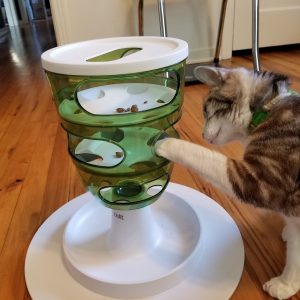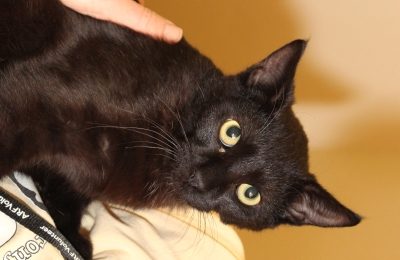Most of us are right-handed, with 9% of humans being left-handed, and about 1% leaning toward some level of ambidexterity. But what about our pet cats? Well, thanks to science, we do know a little bit about whether cats are “right-pawed” or “left-pawed.” In fact, there have been at least 9 papers spanning almost 65 years of research looking at the paw preferences of cats. These studies usually use a food-related task, but some have used a light beam or toy to stimulate cats to approach and touch a stimulus. The paw that is used to touch or approach reflects a cat’s “paw preference.”
Previous research has suggested that unlike humans, cat pawedness is a bit all over the place. For example, in 1955, tests of paw preference in 60 cats showed 20% to be right-handed, 38% left-handed, and 42% to be ambidextrous (Cole, 1955). However, these preferences can be very stable, and a 1997 paper reported that 60% of cats used their preferred paw 100 percent of the time (Pike & Maitland, 1997)! The effect of paw-preference also appears to be strongest for a food-related task. When cats are tested with a toy, they seem to be much more ambidextrous in their reaching behavior (Wells & Milsopp, 2009).
There are also sex effects of pawedness in cats. In 1990, researchers tested the paw preferences of 66 cats by having them reach into a hole for a piece of food. Male cats were slightly more likely to be left-pawed, and females were more likely to use their right paw to get the food (Tan et al., 1990). The tendency of males to be lefties and females to be righties has been found in other studies, and in fact, when female cats are given an intramuscular injection of testosterone, their right-paw preference is weakened (Tan et al., 1991).
A new study looked at whether there were breed differences in paw preferences. The study, “Laterality as a tool for assessing breed differences in emotional reactivity in the domestic cat, Felis silvestris catus” was recently published and is open-access in the journal Animals. Now personally, I think the title is a bit misleading, which I’ll get to later. First let’s review the study and what the researchers found.
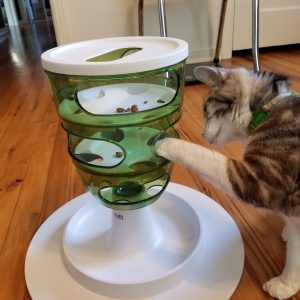
Cats of four breeds (Persians, Maine Coons, Ragdolls and the hybrid breed Bengals) were tested. These breeds were chosen because they are often described as having distinct personality characteristics related to emotional reactivity. Fifty-six owned cats between the ages of 1 and 9 participated in the study, which occurred in each cat’s home. The cats were tested for paw preference with 50 trials at the Catit Senses Food Maze. The Catit is a tower-style food puzzle that requires cats to fish food out with a paw, and the food in question for this study was “Dreamies” cat treats (note for US readers, Dreamies is just the Euro version of “Temptations!”). Each cat was given 10 treats at a time until they had made 50 choices, and the paw they used to try to get a treat out (regardless of whether they were successful) was recorded. Then the results were analyzed to see if the choices that cats made were different from what you would expect by chance.
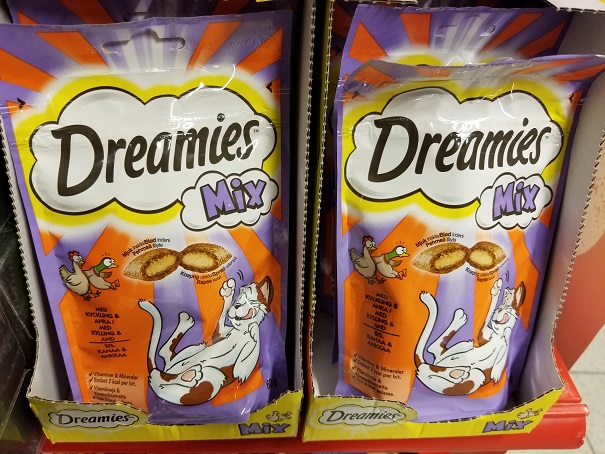
As found in previous studies, some cats were left-pawed (45%), some right-pawed (35%) and some ambilateral (20%). As in previous studies, As far as breed differences are concerned, only Bengal cats showed a somewhat consistent paw preference, with over 80% of the 12 Bengal cats being left-paw dominant. Ragdolls and Maine Coons were more likely to have a paw preference than be ambilateral, whereas Persian cats were equally likely to be left-pawed, right-pawed or ambilateral.
So what does it all mean, and should we even care about what paw your cat prefers to use? Generally it appears that all vertebrate (and maybe some invertebrates) show a trait known as lateralization. This means that the separate hemispheres of the brain may be specialized for particular tasks, and the two halves of the brain are not exactly the same in their function or the information they process.
Generally speaking, your dominant limb corresponds to the opposite hemisphere of your brain. Right-handedness reflects the dominance of the left brain hemisphere. So…back to the title of this paper, “Laterality as a tool for assessing breed differences in emotional reactivity in the domestic cat.” Hey, where did the emotional reactivity come from? The research didn’t look at any personality/temperament traits in the cats who were tested, only at their paw preference. So how can laterality help us understand emotional reactivity?
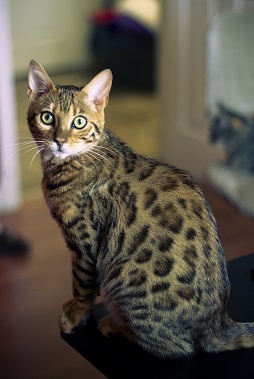
Some other research in other species has linked the right hemisphere of the brain with aggressive behavior and heightened responses to threatening stimuli. A previous survey-based study suggested that Bengal cats are highly predatory, and some non-peer reviewed work suggested that Bengals show more aggressive behavior than other breeds of cats. Based on that, the authors make a wee bit of a s t r e t c h that the lefty tendencies of Bengals are an indicator of emotional reactivity. Now, that may (or may not) be true, but it’s not what the authors actually tested, which is why I think the title of the paper is rather misleading. And although it’s convenient that their results for Bengals are in the same direction of their prediction, we shouldn’t mistake this for direct evidence of emotional reactivity.
Aside from that, I think this is a nifty study – which you can even replicate in the privacy of your own home if you have cats who are willing! Complementing the paw preference test with other measures of behavior and personality would help us better understand whether there is a relationship between pawed-ness and emotional reactivity. But for now, we can say that for whatever reason, it seems that Bengal cats are definitely left-leaning!
References
Cole, J. (1955). Paw preference in cats related to hand preference in animals and men. Journal of Comparative and Physiological Psychology, 48(2), 137.
Fabre-Thorpe, M., Fagot, J., Lorincz, E., Levesque, F., & Vauclair, J. (1993). Laterality in cats: paw preference and performance in a visuomotor activity. Cortex, 29(1), 15-24.
Pike, A. V. L., & Maitland, D. P. (1997). Paw preferences in cats (Felis silvestris catus) living in a household environment. Behavioural processes, 39(3), 241-247.
Tan, Ü., Yaprak, M., & Kutlu, N. (1990). Paw preference in cats: Distribution and sex differences. International Journal of Neuroscience, 50(3-4), 195-208.
Tan, Ü., Kara, I., & Kutlu, N. (1991). The effects of testosterone on paw preference in adult cats. International journal of neuroscience, 56(1-4), 187-191.
Wells, D. L., & Millsopp, S. (2009). Lateralized behaviour in the domestic cat, Felis silvestris catus. Animal Behaviour, 78(2), 537-541.
Wells, D. L., & McDowell, L. J. (2019). Laterality as a tool for assessing Breed differences in emotional reactivity in the domestic cat, Felis silvestris catus. Animals, 9(9), 647.

